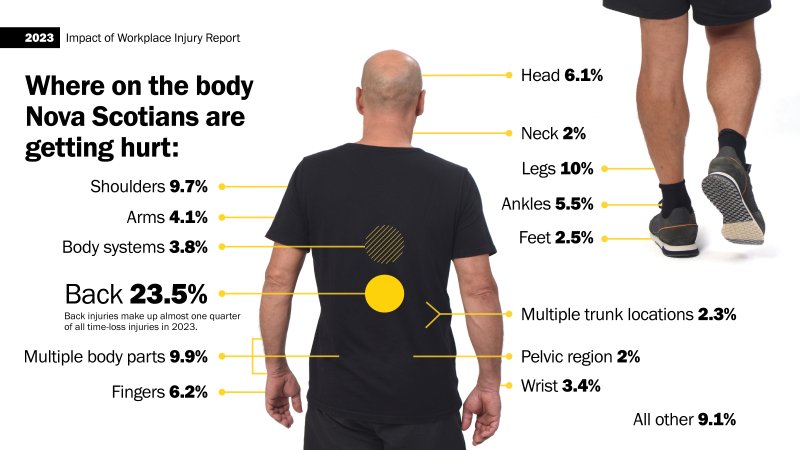Musculoskeletal Injuries (MSIs)

The most common type of injury
Musculoskeletal injuries (MSIs) involve our muscles and skeleton. They can also affect tendons, ligaments, joints, nerves, and blood vessels. Some everyday names for MSIs are
- sprains and strains
- over-exertion
- soft tissue damage
- repetitive strain
In 2023, industries in Nova Scotia saw:
- 3,309 sprain and strain injuries reported
- 65 inflamed joint, tendon, or muscle injuries reported
These statistics highlight the importance of improving safety practices and providing adequate training to reduce injuries and reduce the human and financial cost of workplace injuries.
Over 63% of all workplace injuries were MSIs in 2023:
- 2% of time-loss injuries were caused by risky or repetitive movement
- 4% of injuries were sprains and strains
- 1,109 time-loss injuries were sprains and strains where workers missed 3 or more days of work due to their injuries
What causes MSIs?
- Doing the same movement over and over again
- Lifting, pushing, or pulling heavy loads
- Standing or sitting in an awkward position for a long time

How to prevent MSIs
Follow these safety tips and information guides to improve MSI safety in your workplace.
- Use this OHS Risk Mapping Tool Kit to identify and control potential sources of MSI injury in your workplace.
- Follow this Inspection checklist to find out which tasks have the highest risks.
Get step-by-step instructions on how to build awareness, identify hazards, assess risks, implement controls and more in this MSI Prevention Guide
Watch this to learn more about preventing sprain and strain injuries in your workplace.
Summary:
- Introduces musculoskeletal injuries (MSIs) as common workplace injuries affecting muscles, tendons, ligaments, and nerves, highlighting their high occurrence, associated direct costs (e.g., physiotherapy, wage replacement), and indirect costs (e.g., productivity loss, absenteeism).
- Explains ergonomics as the science of matching jobs and environments to worker capabilities and limitations to prevent MSIs, emphasizing proactive identification of hazards and risk factors.
- Details the Workers Compensation Board’s Six-Step Prevention Guide, including employee engagement, education and awareness, risk identification, risk assessment, control implementation, and evaluation, with flexibility for integration into existing workplace systems.
- Describes three practical tools for MSI prevention: Risk Mapping Tool (high-level organizational overview), Discomfort Survey (role/task-level early warning system), and Workplace Inspection Checklist (task-level observational assessment).
- Highlights the importance of quantifying risk factors—repetition, awkward posture, heavy loads, inadequate breaks, temperature, vibration, contact stress, and psychosocial factors—to align job demands with worker capabilities and reduce injury risk.
Intended Audience:
- Employers, safety officers, supervisors, ergonomists, HR professionals, and employees responsible for health, safety, and MSI prevention in workplaces across industries.
Make the job fit the worker
Put these posters up around your workplace to remind people of the safest way to work.
Push, don't pull to protect your back
Don't twist when you lift, to protect your back
Is there a tool for that? Protect your back
Industry tip sheets
Share these tip sheets to make work safer: